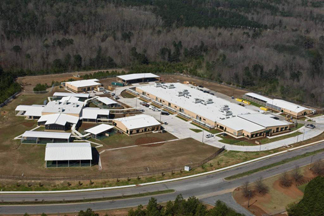Beagle Brigade

NEWNAN, Ga. — There’s no question that LEED certification has not gone to the dogs. Earning the certification was even important to the U.S Department of Agriculture when its planners were designed the new National Detector Dog Training Center, which earned LEED Gold certification.
The facility accommodates training dogs and their handlers that are assigned to safeguard the nation against potentially harmful invasive plants, vermin and insects that arrive in the U.S. at airports, shipping ports and border crossings. At stake are hundreds of millions of dollars worth of potential damage to the nation’s agriculture and food supply.
The campus in Newnan, Ga., near Atlanta, is situated on 17 acres, making it the largest USDA dog training facility in the United States. The center can accommodate up to 100 dogs – primarily Beagles rescued from shelters — whose friendly disposition, small size and acute sense of smell make them ideal sleuths to inspect airport luggage conveyors and carousels, post office sorting belts, vehicles at border checkpoints and warehouses. The dogs and handlers must first undergo 10 to13 weeks of training. Those that pass muster join the elite "Beagle Brigade," operated by the USDA’s Animal and Plant Inspection Services, and are assigned to stations across the country. The Detector Dog mission has become part of the Department of Homeland Security and some dogs are now stationed overseas.
At the outset, USDA officials told Tucker, Ga.-based design-build firm, Rooker, that they required seven buildings totaling approximately 100,000 square feet with uses ranging from a quarantine facility to veterinary clinic. Kennels, an administration and training building and a building for canine agility conditioning were also included with the project. The facility’s master plan calls for an eventual 128,000-square-foot complex with nine buildings ranging in size from 8,000-square-feet to more than 60,000-square-feet.
Rooker built the complex and leased it to USDA for 20 years. From the start, Rooker had the inside track for the opportunity since it already owned a site that met the required proximity to Hartsfield-Jackson Atlanta International Airport, whose numerous international flights provide the dogs a real-world training environment beyond the simulations at the USDA Center.
The project’s metal building systems, designed by Butler Manufacturing, include structural framing and a standing seam metal roof system.
The facility’s energy-management system and CO2 sensors, advanced interior lighting controlled by occupancy sensors and programmable exterior lighting fixtures contributed to its LEED Gold certification.
Additionally, an HVAC system fitted with energy-recovery wheels and electronic controls provide 15 air exchanges per hour. These elements, combined with low-VOC finishes, contribute to an environmentally friendly indoor environment. A Reflective coating was also specified for the metal roof, as well as light-colored concrete on the ground, to reduce heat-island effect across hard-surfaced areas.
The project’s infrastructure includes bicycle racks and shower/changing room facilities, as well as preferred parking for fuel-efficient vehicles and carpoolers. A storm-water management strategy incorporates an oversized detention pond and 40,000 gallons of underground storage for collected rainwater used for toilets and kennel washing.
